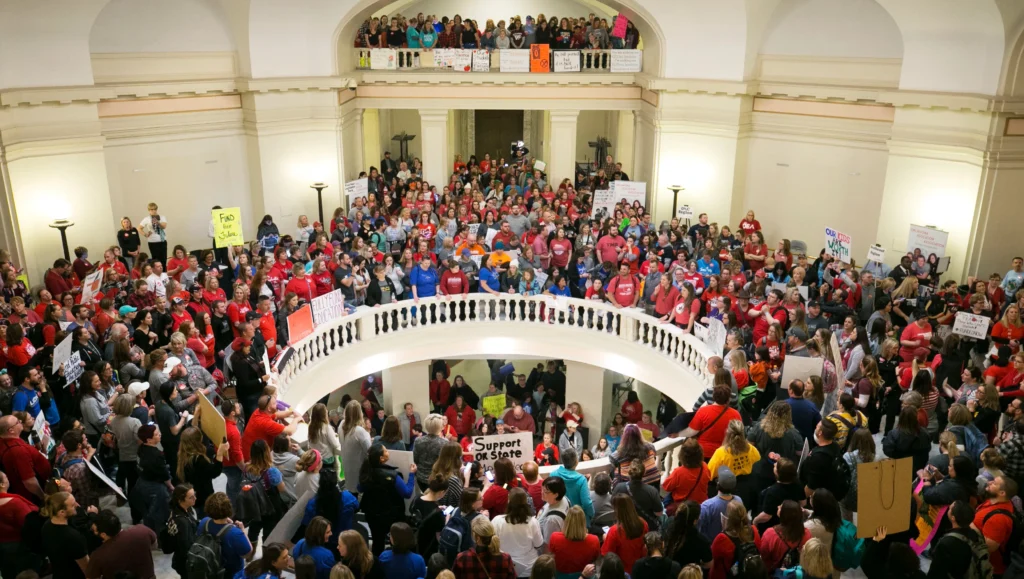April 7
Reflections from week one
I have been honored to be the resident DJ and the meddling stagehand at the walkout this week. Being witness to this event and the power of workers standing together in solidarity has been amazing. Walking up on the second day and realizing that everyone came back made it real in a big way. It really got me and I am thrilled to play a part. They are redefining what is politically possible. The stories and speeches, the performances and brilliant signs all coming together in a message of standing together and fighting for each other, for our children and our future as a state has been awe inspiring.
Now, we have a chance to change history in a state that has been going backwards for far too long.
The Oklahoma House “historically” managed to get more than 76 votes for a revenue raising measures, no less than three times, out of the House of Representatives for the first time in 28 years. It has raised approximately $400M and has been signed by or sent to the Governor.
Curiously, the current plan signed into law fails to meet the Oklahoma Education Association (OEA)’s demands and leaves teachers, support workers and state employees struggling to provide the services they are tasked to provide. Between a failed state question for teacher pay raises, the OEA’s Fight for Funding campaign and a variety of local and national coverage, the case has been made for teachers and their need for a raise and more funding, but I’d like to take a moment and ask, what about state employees?
The case for state employees
Like teachers, state employees haven’t had raises in more than a decade. While that is a similar story shared across our nation, it has a devastating impact on workers. Not getting a raise in a decade means employees starting today feel like they are making $6,000 less than employees of a decade ago based on purchasing power lost to inflation.
As the costs of rent, college and health care have risen, wages have remained the same. State employees starting today have an objectively worse standard of living than just those of a mere decade ago. This has all sorts of labor market impacts and the decades of cuts have made what once we decently stable jobs, anything but that.
There are many examples of the problems with the employment situation for state workers. Lowpage leaves them significantly under market rates. The state has also been shedding workers as the state’s population has climbed. This cannot continue. State workers, like teachers, will eventually reach the breaking point. Based on the statistics below, you can see many agencies where that is already happening and these agencies provide things from vital public safety to services to the most vulnerable people we have. Something has to change.
A different animal than education
Unlike teachers, state workers hail from a variety of professions and silo into very diverse agencies with divergent management and internal cultures. Many state workers feared to go on the record saying much of anything. The data below shows vastly different employment climates across many agencies.
One worker, Jezy Gray, a modestly paid digital content writer promoting Oklahoma’s third largest industry in the state in the Tourism Department, said of his current concerns, “Our take-home pay is going down as our health insurance costs go up.” State employees while getting coverage for their family, had their rates capped a few years back. Now each annual increase in health insurance costs means they take home less and less without an offsetting raise.
In discussing the lack of solidarity in the rank and file state employees, Gray said, “Before the walkout, I didn’t really identify politically as a state employee, even though I’m on the public payroll.” Gray though has joined his worker association, the Oklahoma Public Employees Association (OPEA) and taken time off to be at the Capitol to stand with teachers and workers and demand better pay and support. He also expressed while his job was fairly comfortable, he had deep concerns about workers in other agencies whose jobs carried greater stress, risk and in some cases, even lower pay.
Other conversations with workers hinted at a culture of fear, where speaking out could lead to reprisal and rocking the boat was strongly discouraged. Some agencies publicly approved the taking of leave to attend the strike and many state workers have shown up at the capitol, but taking leave and striking are not the same thing.
Sheri, a DHS worker out of Blackwell, has 17 years experience and a masters in business administration. As her W2 indicates, she makes less than a first year teacher.
She also mentions the issue of insurance rates going up while her pay stagnates. Each year that small paycheck gets smaller. This is incredibly demoralizing.
The real fraud, waste and abuse
These words are the hallmark of any good, conservative legislator but what does that look like in reality?
Agencies are frequently audited and spending is documented in detailed, public records. With years of belt tightening and slashing programs, any reasonable person would question how abuse and waste can exist in such an austerity focused environment where the competition for resources is fierce.
What is more likely and based on the stats below is that you are actually introducing more waste by forcing agencies to hire less ideal candidates willing to accept increasingly low pay. Paying people far below market rate drastically increases the likelihood they can and will find a better deal elsewhere. Having too few hands to do more work means you end up spending your days shuffling a crushing workload around instead of getting down to the business of delivering services. There are many ways to hold people accountable. Giving them impossibly small budgets to do too much work and disastrously low pay makes your operation run worse, not better.
The Stats
Below is a table about turnover rates. Private sector turnover rates tend to be much lower and government turnover rates are supposed to be some of the lowest across all employment sectors. What is happening in Oklahoma is a complete anomaly and deeply troubling.
Over the last 15 years, we’ve seen the involuntary rate of turnover more than double as a share of total turnover rate. This means as budget cuts have increased, more people are being forced out to reduce costs. Often, it is your most experienced and highest paid people that go first. Agencies are doing more and more with less, despite the fact that Oklahoma has grown 14% or 500,000 people since the early 2000’s. The overall turnover rate has increased 50% since the early 2000’s.
Table 3: Classified Employee Turnover Rates FY 2000-2016
Year Overall Voluntary
Rate Rate
2016 20.50% 16.40%
2015 18.10% 14.60%
2014 17.70% 13.85%
2012 16.50% 13.80%
2011 13.00% 10.30%
2010 13.90% 10.80%
2009 13.20% 10.40%
2008 14.10% 11.70%
2007 13.90% 11.60%
2006 14.80% 12.30%
2005 12.90% 10.80%
2004 12.50% 10.80%
2003 11.20% 9.60%
2002 11.80% 10.30%
2001 12.70% 11.40%
2000 13.50% 12.10%
Below are 15 of the largest agencies by appropriations and their staffing summaries. You have some incredibly large agencies that are shedding 1/3 of their workforce ANNUALLY. Another interesting takeaway is noting which agencies have the lowest turnover vs highest. It tracks almost perfectly with either stable funding or high pay. Health Care Authority (many of our state medical providers) and Department of Public Safety (State Trooper and other law enforcement) tend to make higher, more competitive salaries with the private sector. They also have relatively stable appropriations that don’t fluctuate wildly year over year. The Department of Transportation has large, stable dedicated revenue streams to maintain our state highways and other roads and thus have much more stability and lower turnover.
Alternatively, Department of Human Services, Department of Corrections, Office of Juvenile Affairs, Mental Health/Substance Abuse Services and Department of Veterans Affairs deal with some of the toughest, most vulnerable people in our society and are stuffed full of incredibly low paid social workers, orderlies and corrections workers with astronomical caseloads and decimated supports. These agencies collectively make up nearly 40% of our state government employees.
Veterans Affairs is particular terrifying as much of this is nursing home staff and nearly 45% are leaving annually.

Moreover, whether it is voluntary out benefits offer (VOBO) or retirements, the large numbers of people being moved out each year hurts performance. Some moves are more damaging than others but it is well-documented that hiring and training is expensive for any organization. The demand for these services is not decreasing, so for every person you lose, you are spending to replace them.
What now?
In conversations with state workers, the cuts are hurting and people are afraid to speak out for fear of losing their jobs. Something has to change the balance of power.
Like teachers, state employees have tremendous power. The low pay, tough conditions, insane turnover and increasing stress means that you have too few workers doing too much. This gives a small minority power to stop state services. If workers decide they’ve had enough, it will not take huge numbers to force agencies to shut down. Given the number of annual retirements or turnover in first year employees, if those two groups alone organized and coordinated their efforts, you could shut down significant portions of the state government.
Withholding their labor is the last act workers can do to force the hand of those making demands on their labor. As the conditions deteriorate, they will struggle to find adequate workers to take the available spots, this gives labor more leverage. At this moment in time, there is an opportunity for state workers to demand action from the legislature. Joining with teachers on the picket line, they have the power to force the legislature to get more funding for raises and operations of vital state services.
There are rumblings across agencies that management would be completely unable to deal with a walkout by state workers. High turnover and low pay mean there are not bodies to replace the vacancies they already have across several large state agencies. Firing a bunch of striking workers would be a disaster. In the case of the Department of Human Services and under the auspice of the Pinnacle Plan, which was a legal measure forced on them by a lawsuit brought against them for poor internal standards and the abuse and death of children in their care, it requires certain staffing in critical areas like child protective services. Few, if any workers, could be fired or one of the largest state agencies would find itself in violation of the laws governing it. A brief, but serious disruption of services could be just the motivation the legislature needs to find additional funding that is readily available.
State workers have the same rights as everyone to a living wage, safe working conditions and most importantly, the ability to do their jobs right. Countless children and vulnerable adults are hurt every year due to a drastically underfunded state government required by law to provide services for these citizens. Austerity is failed policy but becomes madness in a state with a rapidly growing population and high amounts of need for state services. The stagnant or reduced funding puts incredible pressure on state workers. It is time for them to decide if they have had enough.




